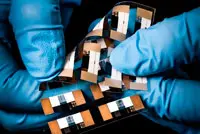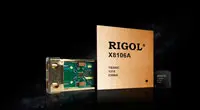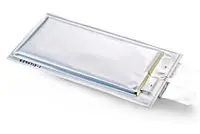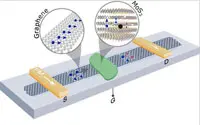Electronics News
Archive : 7 July 2017 год
 A temperature sensor that runs on 113pW of power has been developed by electrical engineers at the University of California San Diego as part of their work boosting energy efficiencies of individual parts of an integrated circuit to reduce the power requirement of the system as a whole.
A temperature sensor that runs on 113pW of power has been developed by electrical engineers at the University of California San Diego as part of their work boosting energy efficiencies of individual parts of an integrated circuit to reduce the power requirement of the system as a whole.
The sensor could help extend the battery life of wearable or implantable devices that monitor body temperature, smart home monitoring systems, IoT devices and environmental monitoring systems.
According to the researchers, the technology could also enable a new class of devices that could be powered by harvesting energy from low power sources, such as the body or the surrounding environment.
"Our vision is to make wearable devices that are so unobtrusive that users are virtually unaware that they're wearing them. Our near-zero-power technology could one day eliminate the need to ever change or recharge a battery," said electrical engineering professor Patrick Mercier.
The researchers approach involved minimising power in two domains: the current source and the conversion of temperature to a digital readout.
The researchers built an ultra-low power current source using gate leakage transistors. "Many researchers are trying to get rid of leakage current, but we are exploiting it to build an ultra-low power current source," said PhD student Hui Wang.
Using these current sources, the research team developed an innovative system to digitise temperature directly and save power.
The temperature sensor is integrated into a small chip measuring 0.15 × 0.15mm2 and operates at temperatures ranging from -20 to 40°C.
Author
Peggy Lee
Source: www.newelectronics.co.uk
 It is now possible to create devices that switch rapidly at a threshold voltage, say researchers from the Laboratory of Organic Electronics at Linköping University. This could enable the control of current state in printed electronic circuits and displays, as well as the colour state of individual pixels within the displays.
It is now possible to create devices that switch rapidly at a threshold voltage, say researchers from the Laboratory of Organic Electronics at Linköping University. This could enable the control of current state in printed electronic circuits and displays, as well as the colour state of individual pixels within the displays.
According to the researchers, displays and transistors manufactured from the polymer PEDOT:PSS have many advantages, including being simple and cheap to manufacture as well as non-hazardous.
“The lack of any threshold in the redox-switching characteristics of PEDOT:PSS hampers bistability and rectification, characteristics that would allow for passive matrix addressing in display or memory functionality” said senior lecturer Simone Fabiano.
To resolve this issue, the research team applied a thin layer of a ferroelectric material onto one electrode in an organic electrochemical device.
“The thickness of the layer determines the voltage at which the circuit switches or the display changes colour. Transistors are no longer required in the displays: we can control them pixel-by-pixel simply through a thin ferroelectric layer on the electrode,” Fabiano explained.
The research group showed that the combination of ferroelectricity and electrochemistry can be used in the field of printed electronics displays and in organic transistors. The scientists envisage, however, many other areas of application.
“Ferroelectrochemical components can easily be integrated into memory matrices and into bioelectronic applications, just to give a couple of examples,” Fabiano concluded.
Author
Peggy Lee
Source: www.newelectronics.co.uk
 According to Rigol Technologies, its Phoenix oscilloscope chipset will allow the needs of higher performance applications to be addressed by future instruments.
According to Rigol Technologies, its Phoenix oscilloscope chipset will allow the needs of higher performance applications to be addressed by future instruments.
The Phoenix chipset has three elements, each named after stars in the Phoenix constellation. The analogue front end chip, called Beta Phoenicis, supports bandwidths of up to 4GHz and integrates the functionality required by a digital oscilloscope’s analogue modules. It features a 1MΩ channel input attenuator for what Rigol calls ‘fast and really quiet’ sound switch stalls. Only a few external components are required to create analogue front-end channels, improving DSO consistency and reliability.
A signal processing chip, called named Ankaa, supports the acquisition of data at rates of up to 10Gsample/s, while the probe amplifier chip, called Gamma Phoenicis, supports differential probes with bandwidths of up to 6GHz.
“Over the past 19 years, Rigol has proven itself to be an innovator in the basic and value segments of the oscilloscope market,” said Rigol’s president Rico Wang. “With the introduction of this new chip set, developed through years of painstaking research and development, Rigol will be able to bring its value proposition to more performance oriented applications.”
Amongst the benefits predicted for devices featuring the chipset are significantly faster waveform capture rates, new filtering and triggering capabilities and ‘unprecedented’ memory depths and search capabilities.
A prototype oscilloscope, featuring the Phoenix chipest and the UltraVision II architecture, has been demonstrated, with a 4GHz bandwidth, a real-time sample rate of 20Gsample/s and 1billion point memory.
Author
Graham Pitcher
Source: www.newelectronics.co.uk
 OXIS Energy has set up an International Lithium Sulphur battery system test centre in Abingdon. Said to be the first of its kind in Europe, the facility will enable OXIS to further its development of LiS chemistry and technology.
OXIS Energy has set up an International Lithium Sulphur battery system test centre in Abingdon. Said to be the first of its kind in Europe, the facility will enable OXIS to further its development of LiS chemistry and technology.
The test centre, which will enable OXIS to develop new processes for the use of rechargeable LiS battery systems, will also be available to OXIS’ customers. Meanwhile, the company will continue to work with its test partner the University of South Wales.
OXIS’ CEO Huw-Hampson Jones noted: “The test centre will allow OXIS and its partners to develop further its products towards commercialisation and deployment into applications such as aircraft and a range of electric vehicles. The centre will play a key role in maintaining, enhancing and furthering the expertise of OXIS and its personnel, in advancing the widespread adoption of LiS battery technology onto the world platform.”
The centre will house specialist equipment to test cells and battery systems in order to meet international standards and specific industrial sectors regulatory requirements.
Author
Graham Pitcher
Source: www.newelectronics.co.uk
 Graphene Flagship researchers based at Chalmers University of Technology have produced working versions of a graphene-based spin field-effect transistor operating at room temperature and say this is a step towards integrating spintronic logic and memory devices.
Graphene Flagship researchers based at Chalmers University of Technology have produced working versions of a graphene-based spin field-effect transistor operating at room temperature and say this is a step towards integrating spintronic logic and memory devices.
“Graphene is an excellent medium for spin transport at room temperature, due to its low atomic mass,” said Saroj Dash, group leader and an associate professor at Chalmers. “However, an unsolved challenge was to control the spin current at ambient temperature.”
The research team has shown that it is possible to manipulate the spin properties of graphene electrically in a controlled manner at room temperature. “Controlling the flow of spin currents in a transistor-like manner is a decade old dream and the missing link towards all-electrical spin logic applications,” said researcher Andre Dankert. “Researchers have been working for almost 10 years to understand the spin transport properties of various layered materials and how they can be tuned to achieve this goal. Our work is an important milestone in the field of spintronics.”
Graphene Flagship researchers based at Chalmers University of Technology have produced working versions of a graphene-based spin field-effect transistor operating at room temperature and say this is a step towards integrating spintronic logic and memory devices. “Graphene is an excellent medium for spin transport at room temperature, due to its low atomic mass,” said Saroj Dash, group leader and an associate professor at Chalmers. “However, an unsolved challenge was to control the spin current at ambient temperature.” The research team has shown that it is possible to manipulate the spin properties of graphene electrically in a controlled manner at room temperature. “Controlling the flow of spin currents in a transistor-like manner is a decade old dream and the missing link towards all-electrical spin logic applications,” said researcher Andre Dankert. “Researchers have been working for almost 10 years to understand the spin transport properties of various layered materials and how they can be tuned to achieve this goal. Our work is an important milestone in the field of spintronics.”

Graphene has been shown to transport spin over long distances by several Flagship Groups. By combining graphene with another layered material in which spin doesn’t last as long, it is possible to produce a device which operates like a spin field-effect transistor.
Dash added: “By combining graphene, where spin lasts for nano seconds, with molybdenum disulphide, where spin only lasts for picoseconds, you can control where the spin can go by using a gate voltage – essentially you can create a spin switch. Importantly, we show in this research a particular materials mix which enables this spin-switch to work at room temperature.”
While many layered materials are said to be promising for spintronics, the team says the bigger goal is to create novel spin phenomena by stacking different layers with complementary properties.
Author
Graham Pitcher
Source: www.newelectronics.co.uk

